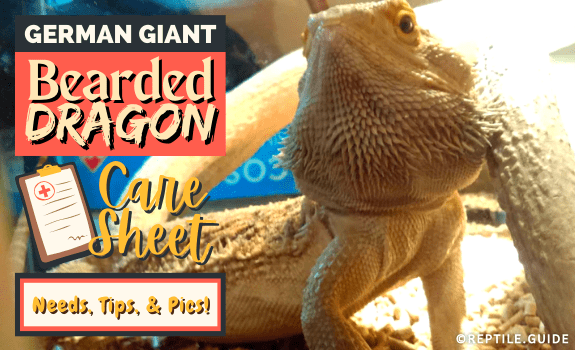The German giant bearded dragon is a rare morph that grows to a much larger size than most bearded dragons.
While you’re unlikely to pick up one of these animals on a quick trip to the pet store, the German giant is an excellent morph with personality to spare.
In This Article
German Giant Bearded Dragon Price
German Giant bearded dragons are rare, and you can expect to pay $300-$500 for a single animal.
Many factors affect the German giant bearded dragon price, including:
- The animal’s age
- Where you buy your German giant
- How many people are breeding German giants
If you buy your baby bearded dragon at the right time, you can pay as little as $150.
Where to Buy German Giant Bearded Dragons
Since German giant bearded dragons are less common than some other morphs, it’s not as easy to find one.
Some of the places you can try include:
| Online Marketplaces |
Online marketplaces like MorphMarket are one of the easiest ways to track down a German giant bearded dragon. These websites host breeders from around the country and the reptile gets delivered to your door via courier. Sometimes, this allows you to get in touch with the breeder, who can give you detailed information about the animal’s background. You might also pick up some tips on how to care for your beardies. |
| Buying Direct from Breeders |
With rare animals, like the German giant, buying directly from a breeder is often preferable. Always research the breeder to ensure that they’re trustworthy. While there’s nothing wrong with supporting a new breeder, there’s no proof that they’re good. It’s best to check a breeder’s reputation by using review sites and asking on forums. |
| Reptile Conventions (Repticon) and Expos |
Many reptile keepers prefer buying their animals in person at the nearest Repticon or expo. These conventions feature breeders from across the United States, and the chances of finding a German giant beardie breeder are high. The people in charge of the convention or expo vet each breeder to ensure that they’re providing a quality service. |
We DON’T recommend buying German giant bearded dragons from pet stores.
You have no guarantee that the animals are labeled correctly, and can’t ask questions about the beardie’s background.
German Giant Bearded Dragon vs Normal Bearded Dragon
German giant bearded dragons are a morph of the bearded dragon, so they have much in common with the regular bearded dragon.
When looking at a German giant bearded dragon vs. a normal bearded dragon, these factors set them apart:
- Size – The German giant bearded dragon is much larger than a standard bearded dragon.
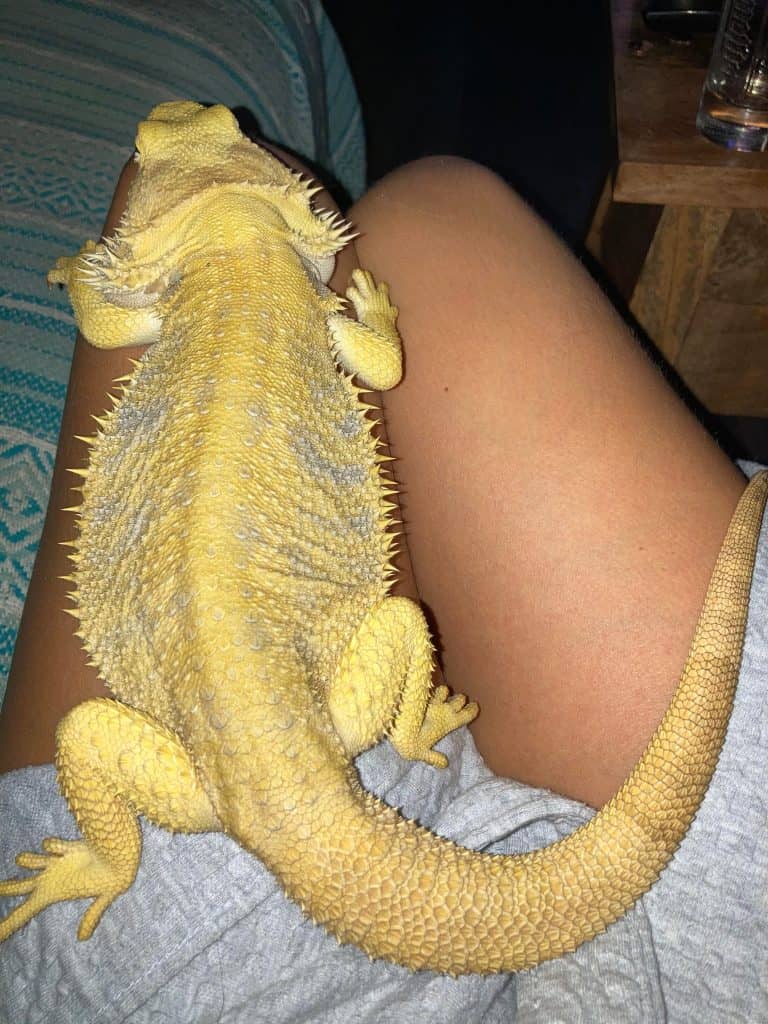
Image credit: u/TangerineThink (via Reddit.com)
- Price – The German giant is more expensive than most standard morphs. However, it’s a morph rather than a species, and it has a price similar to the rarer color morphs. this applies only to rarer colored morphs.
- Rarity – German giant beardies are much less common than standard bearded dragons. Yet again, they compare well to other rare morphs.
- Morphs – German giants are a morph, so aren’t available in many colors. You may see a red German giant bearded dragon, or an albino, but color variations aren’t common. The ones that exist usually come from crosses between the giant and colored morphs.
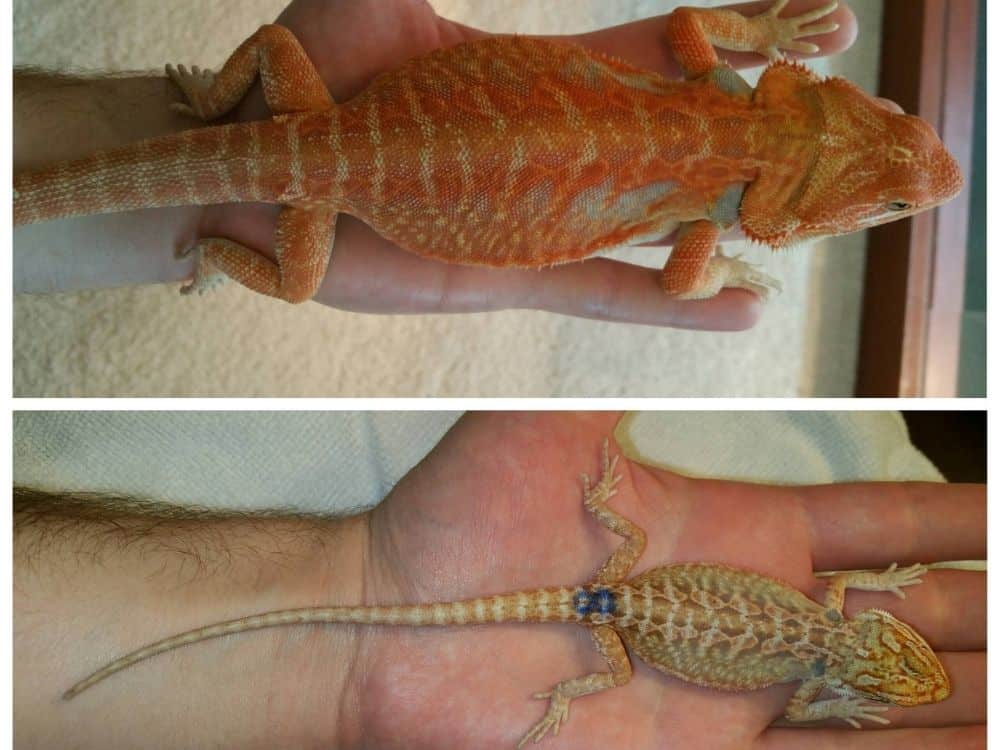
Image credit: u/EchoBrain22 (via Reddit.com)
- Lifespan – Regular bearded dragons generally have a longer average life expectancy than their giant relatives. The average lifespan of a German giant is only four to five years. Regular dragons have a longer lifespan of up to 12 years.
German Giant Bearded Dragon Size
The German giant bearded dragon reaches lengths of up to 30 inches.
Compared to the standard bearded dragon, which only grows to around 24 inches, the German giant bearded dragon is a whopper.
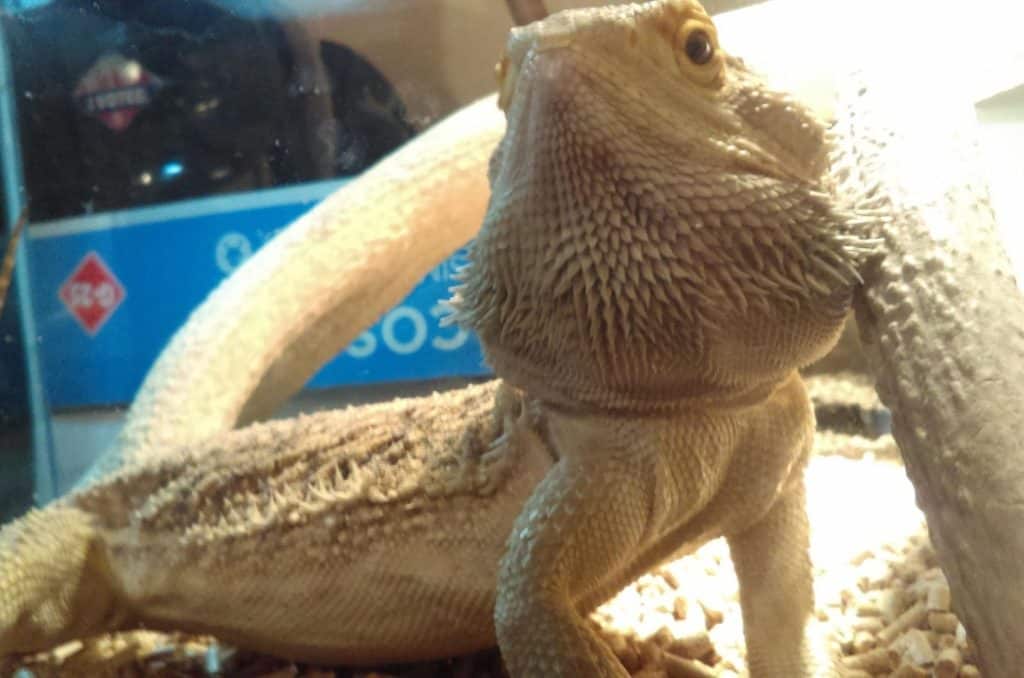
Image credit: u/azmoganv (via Reddit.com)
Thanks to the German giant bearded dragon size, these animals need considerably larger enclosures than their standard counterparts.
German Giant Bearded Dragon Enclosure Setup
Apart from needing more space, the German giant bearded dragon has all the same needs as your average bearded dragon.
Naturally, with a 30-inch size to consider, German giants need much larger enclosures than a normal bearded dragon.
While you can still house a hatchling in a 10-gallon enclosure, Adult German giants need at least a 100-gallon enclosure.
If you’re struggling to find an appropriate enclosure, Custom Reptile Habitats is an example of a trusted brand that can build a custom-sized enclosure for you.
Substrate
Your German giant will happily live on any substrate that works for regular bearded dragons.
There’s one main criterion for a bearded dragon substrate: it shouldn’t cause an impaction when swallowed. Bearded dragons often swallow substrate by accident.
You can try any of the following substrates for your German giant:
| Sand |
While many keepers don’t suggest using sand for your pet lizard, it’s a natural substrate for most beardies. These are desert animals and come from naturally sandy areas. The problem with sand is that it CAN cause impactions. However, if you use a boundary in your cage, you can keep one-third of the enclosure clear of sand. This clear area would be your feeding area. Keeping these areas separate helps reduce the chance of impaction. |
| Newspaper |
Newspaper, and paper pellet products are a common substrate choice for German giant beardies. Since the bearded dragon has a low humidity requirement, paper products work well. It’s also easy to spot clean this substrate, and the dragon is unlikely to eat it. |
| Ceramic tiles |
Some keepers like to use ceramic tiles as a substrate. They’ll give your German giant grip, and you can take them out and wash them. Unless you drop one while cleaning the enclosure, you’ll probably never need to replace them. |
| Reptile carpet |
Reptile carpet is one of the most popular substrates for a German giant or another bearded dragon. It’s washable, so you can use it over and over again. It’s also affordable since you rarely need to replace it. A reptile carpet may look like fake grass, or it may be a simple brown mat. |
You don’t need to stick to only one substrate though. You could easily mix and match to find a setup that works for your German giant.
Heating and Lighting
When trying to heat large lizards like the German giant, you have many heating options. These include:
| Heating pads |
Under-tank heating pads or mats make excellent tools for warming tanks in cold regions. They’re also useful for evening heating. Since most of the warmth reptiles get at night comes from the earth that is soaked in warmth, it’s a natural option. You can hook these heaters up to a thermostat to keep them in range. |
|
Basking lights are a natural option for heating your lizards in the daytime. They warm the enclosure from above, as lizards would naturally get heat in the daytime. However, since these devices produce heat and light, they’re not suitable for use at night. |
|
|
Ceramic heat emitter |
When used along with a full-spectrum lighting system, the ceramic heat emitter is one of the best heating systems. It’s also an aerial heating device, which means it heats the lizard as the sun would in the wild. However, it produces no light, so you can use it for days and nights. If you hook it up to a timer, it will automatically change to a cooler temperature for evenings. |
Pro Tip: If you use any type of heat lamp or ceramic emitters for heating, ensure that the device has a guard. A lamp guard will prevent your beardie from accidentally burning themselves on the light.
Lighting has a significant role in bearded dragon care. UVA and UVB lighting are good additions to an enclosure and can help prevent health issues.
If you’re using a heat lamp, you can simply use UV bulbs for heating and lighting. If you choose ceramic heat emitters or heating pads, then you’ll need to run extra lighting.
Choose a full-spectrum system or one that focuses on UV rays, to ensure your lizard gets everything it needs.
You’ll need to replace UV bulbs every four to six months because they lose efficiency after that time.
The UV rays diminish, even if the light still works.
Temperature and Humidity
The bearded dragon is a desert lizard with relatively high temperature requirements and low humidity requirements.
Aim to maintain the following temperature zones:
- Hot spot – 120-130°F
- Cool end – 70-75°F
- Ambient temperature – 85°F
- Night-time temperatures – 60-70°F
German giant beardies need a temperature gradient in their enclosures. This is because lizards have no internal control over their body temperatures.
This is easily achieved warming one half of the enclosure and leaving the other at room temperature.
Try to maintain a relative humidity of 35-40.
In most places, this should be simple if you use a large, shallow water bowl and mist the substrate daily.
The best way to monitor the temperature and humidity is to install a thermometer hygrometer combo on each side of the enclosure.
This approach allows you to monitor the temperature gradient, and ensure that humidity levels are in range.
Hides and Decor
Bearded dragons don’t need a lot in the way of decoration. However, they’d appreciate a few things in addition to the substrate. The most important include:
| Hides |
Every pet lizard needs places in its enclosure where it can feel safe. Your beardie needs at least two hides. Add a hide to each side of the enclosure so the bearded dragon can rest in the hide that best suits its current temperature needs. A humid hide is also a great idea. It’s a hide filled with moist substrate. It has higher humidity than the surrounding enclosure and helps when the beardie sheds. |
| Water and food bowls |
A large, shallow water bowl is essential for any beardie enclosure. It helps maintain the humidity levels in the enclosure. It also gives the beardie somewhere to drink, and a place to soak if it needs to. Food bowls help protect your dragon from impactions by keeping the food from the substrate. It also helps to prevent insects from escaping into the substrate. |
| Branches or other perches |
While beardies are mainly terrestrial, they’ll appreciate the addition of things they can climb on. Driftwood, dry branches, or custom-made reptile furniture are good choices. |
What Do German Giant Bearded Dragons Eat?
You can feed them the same foods that other bearded dragons eat. Apart from their size and rarity, German giants are much like other bearded dragon morphs.
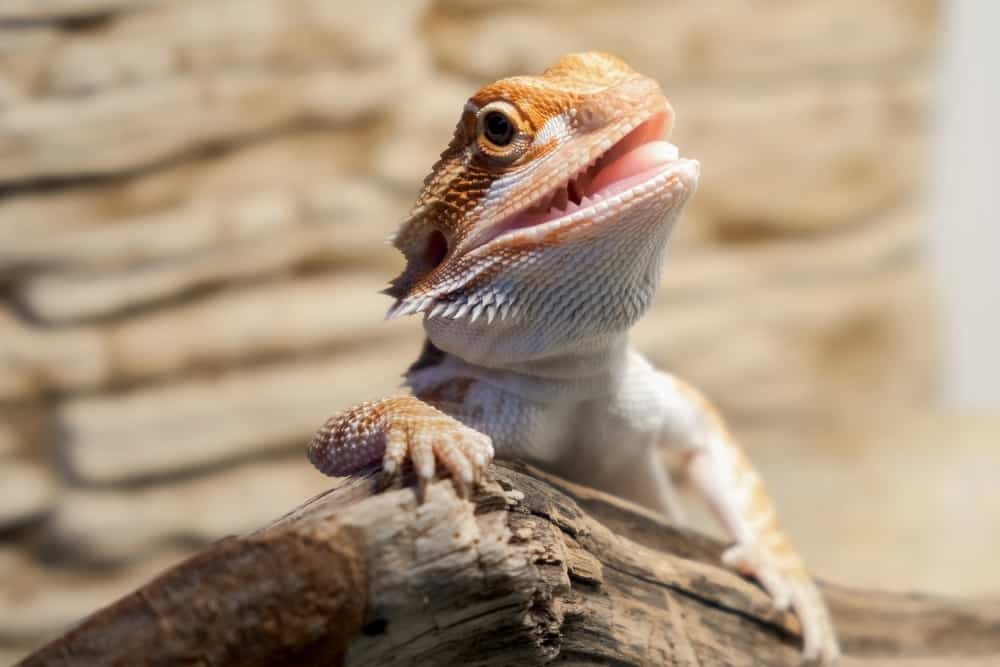
Adult bearded dragons need a diet that consists of 20% live foods, and 80% vegetables. Baby bearded dragons need 80% live foods and 20% veg.
You can also incorporate some fruit into their diets. It should make up no more than 5% of a baby bearded dragon diet, and 15% of the adult meal plan.
Vegetables you may include in a German giant bearded dragon diet include:
Fruit feeding options include:
- Apples
- Papayas
- Peaches
- Strawberries
Your German giant bearded dragon also needs live food. Options include:
- Crickets
- Mealworms
- Earthworms
- Superworms
- Turkistan roaches
- Black Soldier Fly Larvae
It’s best to avoid feeding mealworms as a staple. They have a higher fat content than most other feed on this list. Waxworms are bad for bearded dragons for a similar reason.
New options arrive on the market every couple of years, so keep your eye out for any possible additions.
It’s also important to include a high-quality calcium supplement for bearded dragons in their diet.
Are German Giant Bearded Dragons Rare?
While the German giant bearded dragon isn’t under threat of extinction, it is a rare bearded dragon morph.
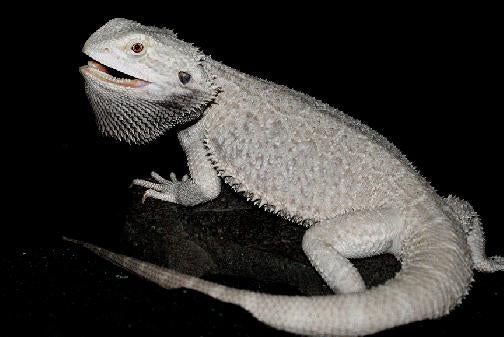
Image credit: u/ScienceTute (via Reddit.com)
Like other rare bearded dragon morphs, some breeders specialize in the German giant bearded dragon.
So, while the German giant morph of the bearded dragon is rare, you can rest assured that it won’t disappear completely.
We hope you’ve enjoyed this article about the German giant bearded dragon. These rare animals make wonderful pets, despite their large size and short lifespans.
There are plenty of other bearded dragon morphs out there. If you’re not sure the German giant is for you, check out some other reptile pets.
Would you buy a German giant if you had the opportunity? Let us know in the comment section.
